求助PDF
{"title":"PEM燃料电池技术的进展:评估操作参数、流场设计、双极板涂层和材料因素的影响","authors":"Aumkumar Patel, S Nishanth, Tushar Patil","doi":"10.1002/jctb.7855","DOIUrl":null,"url":null,"abstract":"<p>Increased greenhouse gas emissions and global warming are driving the world towards going greener by reducing the reliability of fossil fuels and using more and more renewable and green sources of energy. Green hydrogen is emerging as a promising alternative to fossil fuels as it has high mass-energy density, low refueling time, and zero emissions. The polymer electrolyte membrane or proton exchange membrane (PEM) fuel cell is an electrochemical device that converts the chemical energy of hydrogen directly into electrical energy. One of the major factors that obstruct the commercialization of green hydrogen technology is its high cost and limited durability. Hence, researchers around the world are extensively working towards improving the performance and reducing the cost of PEM fuel cells by improving the design and employing alternative materials. This paper focuses on providing a comprehensive overview of the performance parameters of the PEM fuel cell and all the recent advancements in the PEM fuel cell design aspects, such as novel flow field designs and their effectiveness, bipolar plate materials, coatings, and their effectiveness. This study also throws light on types of gas diffusion layers and sealing techniques, as well as materials employed in PEM fuel cell and stack development. This review addresses interdisciplinary advancements and highlights their interconnected effects on polymer electrolyte membrane fuel cell performance and scalability. © 2025 Society of Chemical Industry (SCI).</p>","PeriodicalId":15335,"journal":{"name":"Journal of chemical technology and biotechnology","volume":"100 6","pages":"1159-1190"},"PeriodicalIF":2.8000,"publicationDate":"2025-03-28","publicationTypes":"Journal Article","fieldsOfStudy":null,"isOpenAccess":false,"openAccessPdf":"","citationCount":"0","resultStr":"{\"title\":\"Advancements in PEM fuel cell technology: evaluating the influence of operating parameters, flow field design, bipolar plate coating, and material factors\",\"authors\":\"Aumkumar Patel, S Nishanth, Tushar Patil\",\"doi\":\"10.1002/jctb.7855\",\"DOIUrl\":null,\"url\":null,\"abstract\":\"<p>Increased greenhouse gas emissions and global warming are driving the world towards going greener by reducing the reliability of fossil fuels and using more and more renewable and green sources of energy. Green hydrogen is emerging as a promising alternative to fossil fuels as it has high mass-energy density, low refueling time, and zero emissions. The polymer electrolyte membrane or proton exchange membrane (PEM) fuel cell is an electrochemical device that converts the chemical energy of hydrogen directly into electrical energy. One of the major factors that obstruct the commercialization of green hydrogen technology is its high cost and limited durability. Hence, researchers around the world are extensively working towards improving the performance and reducing the cost of PEM fuel cells by improving the design and employing alternative materials. This paper focuses on providing a comprehensive overview of the performance parameters of the PEM fuel cell and all the recent advancements in the PEM fuel cell design aspects, such as novel flow field designs and their effectiveness, bipolar plate materials, coatings, and their effectiveness. This study also throws light on types of gas diffusion layers and sealing techniques, as well as materials employed in PEM fuel cell and stack development. This review addresses interdisciplinary advancements and highlights their interconnected effects on polymer electrolyte membrane fuel cell performance and scalability. © 2025 Society of Chemical Industry (SCI).</p>\",\"PeriodicalId\":15335,\"journal\":{\"name\":\"Journal of chemical technology and biotechnology\",\"volume\":\"100 6\",\"pages\":\"1159-1190\"},\"PeriodicalIF\":2.8000,\"publicationDate\":\"2025-03-28\",\"publicationTypes\":\"Journal Article\",\"fieldsOfStudy\":null,\"isOpenAccess\":false,\"openAccessPdf\":\"\",\"citationCount\":\"0\",\"resultStr\":null,\"platform\":\"Semanticscholar\",\"paperid\":null,\"PeriodicalName\":\"Journal of chemical technology and biotechnology\",\"FirstCategoryId\":\"5\",\"ListUrlMain\":\"https://onlinelibrary.wiley.com/doi/10.1002/jctb.7855\",\"RegionNum\":4,\"RegionCategory\":\"生物学\",\"ArticlePicture\":[],\"TitleCN\":null,\"AbstractTextCN\":null,\"PMCID\":null,\"EPubDate\":\"\",\"PubModel\":\"\",\"JCR\":\"Q3\",\"JCRName\":\"BIOTECHNOLOGY & APPLIED MICROBIOLOGY\",\"Score\":null,\"Total\":0}","platform":"Semanticscholar","paperid":null,"PeriodicalName":"Journal of chemical technology and biotechnology","FirstCategoryId":"5","ListUrlMain":"https://onlinelibrary.wiley.com/doi/10.1002/jctb.7855","RegionNum":4,"RegionCategory":"生物学","ArticlePicture":[],"TitleCN":null,"AbstractTextCN":null,"PMCID":null,"EPubDate":"","PubModel":"","JCR":"Q3","JCRName":"BIOTECHNOLOGY & APPLIED MICROBIOLOGY","Score":null,"Total":0}
引用次数: 0
引用
批量引用

 求助内容:
求助内容: 应助结果提醒方式:
应助结果提醒方式:


